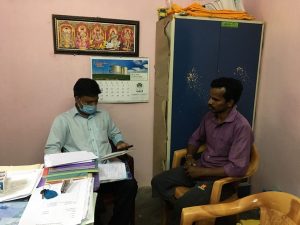Financial Inclusion and a version of ‘space-time’ reality

Financial inclusion has been at the heart of the Indian Government’s economic policy for decades. In spite of this however, there continues to exist a very significant portion of this demographic which has been left unserved. In this, small and marginal farmers (SMF) are significant constituents.
Data shows us that irrespective of the size of their landholding, farmers prefer to avail institutional loans. Ones who have actually availed any, however add up to an abysmal count. About a third of India’s agricultural households still rely on informal sources for funds to cope with various events of distress. Additionally, some other reports are indicative of the fact that allied agricultural activities such as livestock, fisheries and forestry receive only 10% of total agricultural credit while their contribution to total agricultural output is at about 40%. Continued incidence of financial exclusion begs one to question whether the current models of financial inclusion are truly applicable to all that it is directed towards. Many reports suggest that the inability of SMFs in accessing institutional credit and services has much to do with bank requirements of collateral. Credit limits, in the case of many banks, are sanctioned against the size of land possessed. Not only does this mean that the people who require more support find less of it, but also that those belonging to the informal economy are wholly eliminated from eligibility. This includes tenant farmers, sharecroppers, and other agricultural wage labourers as well. It is perhaps now time to come up with new approaches which helps us to understand productivity to be central to creditworthiness, and not the size of landholdings.
In this endeavour, after having discussed the reasons why accessing formal financial institutions is difficult for SMF in India, one must elucidate upon what makes non-institutional financial sources an attractive option as a fallback for this particular group (i.e., apart from the fact that the incompatibility of the existing framework of formal institutions forces them to do so). A study conducted by our team at Bharat Inclusion Research Fellowship (BIRF), across five states — Karnataka, Madhya Pradesh, Orissa, Tamil Nadu and Uttar Pradesh — found that amongst 100 individual farmers interviewed, around 50% of them claimed to turn to Self Help Groups (SHG) for financial support. Even farmers who are members of various Farmer Producer Organizations (FPOs), amongst the 200 interviewed, 14.5% of participants said they depended on SHGs for financial support.
This incidence is explained by the sheer accessibility in space and time. While accessibility vis-a-vis space is rather self-explanatory, accessibility in time requires further deliberation. Current design of financial instruments fails to recognise that the ecological systems and cycles that agricultural production is bound by, do not adhere to financial deadlines. This is another factor which engenders hesitation on part of the farmers in accessing formal financial services, driving them to non-institutional sources. Payment cycles of most SHGs however, are more harvest based. SHGs also dispense loans to those without collateral, thus making them the only viable source for the large population of landless labourers and even those without proper documentation of assets. Formal institutions would perhaps make headway in reaching out to the SMF if they were to take into consideration what works for this population rather than just dumping affordable versions of financial products that were created for an entirely different purpose and demographic onto them. In this regard, formal institutions could perhaps even take a page out of the book of SHGs’ policies to ensure that products offered to SMF are those which can reduce the risk of loan failure (sans the exorbitant interest rates of course), and are compatible with their agrarian background.
If the most marginalised agricultural communities are to join the formal economy, they must first be made to understand what they stand to gain from this. This becomes difficult when the services being offered to them are usually incompatible with their economic, ecological and social realities. Small and marginal farmers are often chronically distressed due to a variety of reasons, and it remains the responsibility of the state to usher in policies which ensure that instruments of financial inclusion are designed in accordance with the realities faced by farming communities.
References:
a) Vasavi, A., 2009. Suicides and the making of India’s agrarian distress. South African Review of Sociology, 40(1), pp.94–108.
b) D’Souza,R., 2020. Improving Access To Agricultural Credit: New Perspectives. ORF Occasional Paper. Mumbai: Observer Research Foundation.
c) Ravi, S., 2019. Accelerating Financial Inclusion In India. [online] Brookings. Available at: <https://www.brookings.edu/research/accelerating-financial-inclusion-in-india/> [Accessed 26 January 2021].
d) Matthew, G., 2019. Financial exclusion: 40.9 per cent of small, marginal farmers not covered by banks. The Indian Express, [online] Available at: <https://indianexpress.com/article/business/banking-and-finance/financial-exclusion-40-9-per-cent-of-small-marginal-farmers-not-covered-by-banks-5996062/> [Accessed 26 January 2021].
